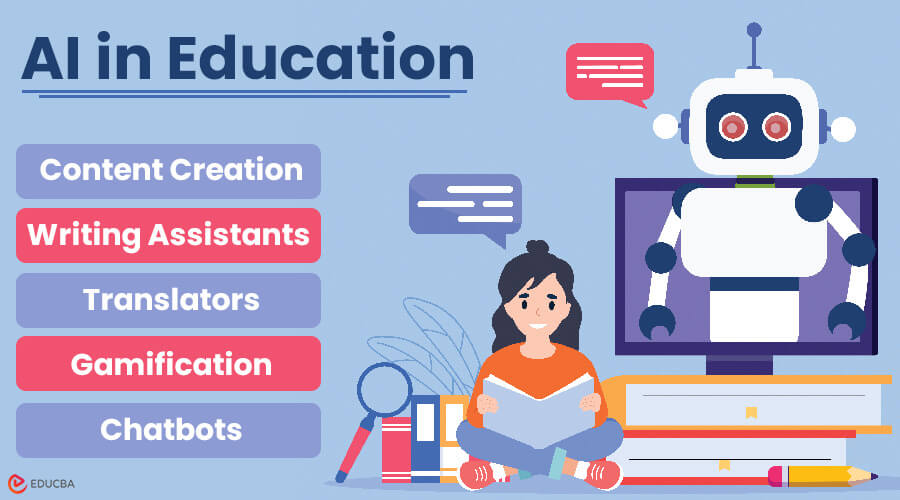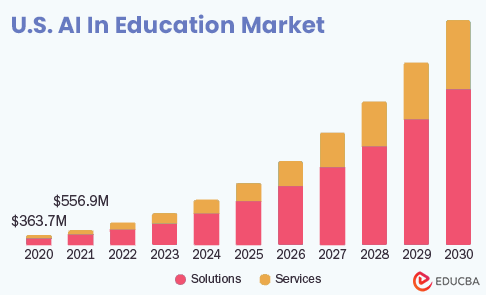What is AI in Education?
AI in Education refers to using artificial intelligence technologies to enhance learning and teaching experiences.
This includes:
- Creating personalized learning experiences for students (using language processing algorithms)
- Simplifying administrative tasks of teachers (using automated grading systems)
- Giving students immediate feedback (using chatbots)
- Building interactive learning environments in a classroom (using virtual reality applications)
Example:
A simple example of AI in education is having a virtual tutor that assists students with Math. This AI tutor can recognize where a student is having trouble and provide extra practice problems customized to their needs. This makes learning more efficient and tailored to each student’s requirements.
How AI is Changing Education?
The influence of AI on education is significant, especially with the rise of generative AI. From learning platforms to administrative tools, AI is increasingly prevalent in educational settings, whether online or onsite.
An example of AI’s utility is catering to individuals who opt for online education but require practical experience. For instance, travel nurses can pursue their studies online while working at various facilities, aided by AI-generated scenarios and simulated patients for hands-on practice.
The applications of AI in education are diverse and numerous. This potential has propelled the market for AI in education to new heights in recent years, driving adoption and transforming the sector significantly.
According to a report by Grand View Research, the global AI in education market reached $1.82 billion in 2021. The projection indicates a CAGR of 36.0% until 2030, with the market expected to approach nearly $30 billion by then. The report also highlights the US market, valued at $556.9 million in 2021, with a CAGR of 34.4%.
(Data Source: Grand View Research)
The widespread adoption of AI tools for studying is evident. 43% of college students in the US currently use generative AI tools, and 90% prefer them over private tutors.
Opinions vary on whether students should use AI for assignments and if educators should encourage its use.
(Data source: Statista)
One of every five Americans believes teachers should prohibit students from using tools like ChatGPT. In contrast, over half believe teachers should educate students on using AI effectively, leveraging its benefits while navigating its potential drawbacks.
Despite varying opinions, it is evident that most students and teachers increasingly depend on AI tools in their daily routines.
Benefits of AI in Education
AI has the potential to revolutionize education in numerous ways. Here are some key benefits of AI in education:
1. Enhances Content Creation
With AI content generators, educators can quickly create lesson plans, activities, and personalized learning materials. AI can also transform existing content into interactive presentations, AI videos, as well as generate original content.
2. Automates Student Task
Students can use AI-powered tools for scheduling, note-taking, and AI research assistance. Automating tasks through these tools helps students manage their time better, focus more on deeply understanding subjects, and enjoy meaningful learning experiences.
3. Generates AI-based Quizzes and Exams
AI can create AI-based quizzes and tests that change based on what each student knows. This helps teachers better understand what students understand and makes learning more personal. It also keeps students interested and helps them focus on what each student needs help with.
4. Improves Administrative Efficiency
AI can significantly streamline unexpected administrative tasks, especially in today’s online learning landscape. AI can help educators who work from different places deal with complicated tax rules. It does this by examining different tax laws and giving them helpful advice tailored to their situation. This use case not only aids remote educators in compliance but also allows them to focus more on teaching and less on remote tax-related paperwork.
5. Provides 24/7 Student Assistance
Chatbots provide immediate answers to student queries and offer unlimited on-demand support outside classroom hours. This ability to work as a student’s virtual assistant makes their lives easier and lets faculty members focus on more critical educational tasks, such as improving the learning process.
6. Automates Grading and Feedback
AI can grade multiple-choice tests and provide feedback to students on specific answer choices. The most advanced AI models can also assess short answers and essays, significantly easing teacher workloads.
7. Personalizes Learning Experiences
AI analyzes student data, pinpoints individual strengths and weaknesses, and creates customized learning paths. That way, each learner works at their own optimal pace.
Personalized learning allows students to learn concepts applied to things they like, care about, or find interesting.
Intelligent algorithms empower a new era in education, where educators can teach financial literacy through highly engaging and personalized learning journeys.
8. Allows Student Self-assessment
Students can use tools like Grammarly to proofread and enhance their writing.
They can also use generative AI tools to create quizzes and practice questions and have the same AI assess their answers, leading to more effective learning.
Applications of AI in Education Technology
There is a plethora of available options for both teachers and students to start using today. Some examples are:
#1. Content Creation
AI in content creation means using AI to create various types of online content, such as:
- Blogs
- Videos
- Music
These programs study a lot of information to understand how to write well and create interesting and useful content.
Most importantly, it can also adjust its writing style to match various topics and audiences. This adaptability enhances the connection between creators and their readers or viewers.
Examples:
- Text generation: ChatGPT (OpenAI), Gemini (previously Bard, by Google), and Copilot (Microsoft).
- Presentation creation and enrichment: io, Beautiful.ai.
- Image generation: DALL-E (OpenAI), Midjourney.
- Audio generation: WellSaid Labs, Murf.ai.
- Video generation: Sora, Synthesia.
- Academic papers and essays: Caktus.ai
#2. AI Writing Assistants
AI writing assistants simplify writing by offering grammar corrections, style suggestions, and vocabulary enhancements. They provide real-time feedback, adapt to different writing styles, and help users improve their writing skills.
Examples:
- Grammarly
- Hemingway Editor
#3. AI Translators
AI translators in education help people understand educational materials in different languages. They help students and teachers communicate better and make learning more accessible to everyone, regardless of their language.
Examples:
- Google Translate
- DeepL
#4. Gamification
Using AI in educational games makes learning more fun and interactive. It adapts challenges and rewards to each student. This personalized approach helps students learn independently and gives teachers useful feedback to support their progress.
Examples:
- Prodigy Education
- Duolingo
#5. AI Chatbots
AI chatbots in education use smart technology to help students and teachers. They answer questions, provide support, and make learning easier. They are available 24/7 and can give personalized advice to improve learning.
Examples:
- Mongoose Harmony
- Amazon’s QnABot
The Future of Education with AI
AI is balanced to play an increasingly significant role in education. Here is what we can expect:
- Adaptive learning at scale: AI will create even more sophisticated adaptive learning systems that cater to individual needs. As a result, it will maximize student engagement and improve outcomes of everything from small classroom sessions to massive open online courses or MOOCs(massive open online courses).
- AI tutors and mentors: Future AI-powered virtual assistants will tailor instruction, offer personalized feedback in real-time, and even act as mentors to provide students with emotional support.
- Intelligent classroom assistants: An emerging concept is the AI agent for education — an intelligent, autonomous assistant that not only supports teachers and students but also continuously learns from interactions to personalize guidance, streamline lesson planning, and improve learning outcomes over time
- Predictive analytics for student success: AI will analyze extensive data to identify at-risk students early. This will allow educators to provide timely interventions and support.
Final Thoughts
As AI becomes more involved in education, it brings both opportunities and challenges. While it has the potential to significantly improve how we teach and learn, we need to be cautious in how we use it and keep a close eye on its impact. Still, AI promises to make education easier to access, more interesting, and better for everyone.
Author: Israel Parada
Israel is a university chemistry professor passionate about data-driven SEO content writing and copyediting. He has written about marketing, business, and personal finance for almost five years as the editor of Yore Oyster.
Recommended Articles
We hope this article on “AI in Education” was helpful to you. To learn more, refer to the articles below.





